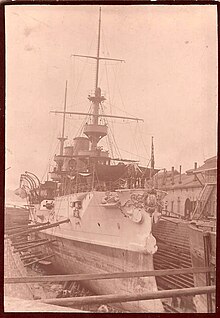USS Albany (CL-23)
She was renamed Albany and launched in February 1899, sponsored by Mrs. John C. Colwell, the wife of the American naval attaché in London.
Steaming via Gibraltar, the Mediterranean Sea, the Suez Canal, and the Indian Ocean, the cruiser arrived at Cavite in the Philippines on 22 November.
For the following nine months, the warship cruised the warm waters of the Mediterranean visiting ports in Greece, France, Italy, Spain and Egypt.
She entered the Atlantic on 18 June 1902 and, after stops at Cherbourg, France, and Southampton, England, rendezvoused with USS Illinois (Battleship No.
She arrived in the West Indies in late November and ended the year in fleet tactical maneuvers which she concluded early in January 1903.
Assigned to the Pacific Fleet, Albany spent the next three years cruising the western coasts of North and Central America.
[3][4][5] On the evening of 16 April 1908, Albany, Commander Henry T. Mayo, commanding, received expedited orders to immediately prepare to depart Mare Island and proceed to San Diego to embark "special peace envoy" William I. Buchanan and then on to Central America for a two-month "peace-keeping" cruise.
[6][7] For the next fifteen months, she cruised the west coast of North and Central America and conducted surveillance missions to protect U.S. citizens and property in the perennially unsettled republics of Mexico, Honduras, El Salvador and Nicaragua, returning to Mare Island on 18 July 1909.
[8][9][10] By January 1909, Albany was transferred from the Pacific Fleet to the Special Service Squadron, signifying her patrol mission and readiness to disembark landing forces to protect American interests in Mexico and Central America.
[11][12] In April 1909, while rendez-vousing with other Navy ships at Magdalena Bay, Baja California Sur, Albany assisted in the rescue of passengers from the stricken mail steamship Indiana that had run aground off Isla Santa Margarita.
Visitors toured the warships and four companies of bluejackets, two from each cruiser, marched in a parade from the Santa Monica, California city hall to the new pier.
[14] In October 1909, while Albany was at Mare Island undergoing repairs and preparing to steam south to Magdalena Bay,[15] she and other U.S. and foreign warships, participated in the Portola Festival at San Francisco, a city-wide fair held on 19–23 October to mark the 140th anniversary of the Portolá expedition, the first recorded Spanish (and European) land entry and exploration of present-day California, and to proclaim to the world that San Francisco was recovered from its devastating 1906 earthquake.
[16] Nicaragua proved to be her primary area of operations during the first part of 1910 when she was attached to Rear Admiral William W. Kimball's Nicaraguan expeditionary force.
At the conclusion of those repairs late in the spring of 1915, Albany was assigned training duty with the state naval militias of Washington and Oregon.
Upon returning to active service, she once again headed for Mexican waters – this time as part of the United States' response to the massacre of American citizens in Columbus, New Mexico, perpetrated by Pancho Villa and his band of marauders.
This change in assignment came as a result of worsening relations between the United States and the German Empire over the latter country's unrestricted submarine warfare campaign.
In February and March relations deteriorated rapidly; and, early in April, the United States entered World War I on the side of the Allied Powers.
For the duration of World War I, the cruiser escorted convoys of merchant ships, cargomen, and troop transports back and forth across the Atlantic.
The United States landed troops at Vladivostok in Siberia, possibly to check Japanese pretensions in that area and to secure that port as an exit for the Czech Legion then transiting the Trans-Siberian railway.


